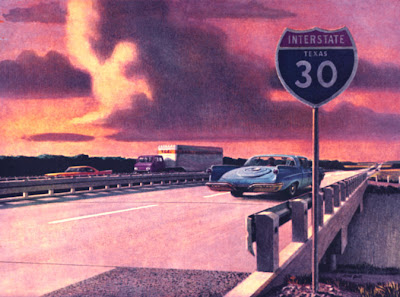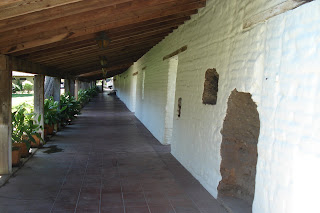 It has been raining here for six weeks. My inner highway was pointing east, towards the Piney Woods. It was a great destination for me and a few buddies to look for some diversion. Clouds were building in the west and lingering storms were still rumbling in the east, but the road called and we had a cooler full of wine and beer. Friends were waiting at the camp, which was on stilts. It might rain, but we’d stay high and dry on the 4th of July.
It has been raining here for six weeks. My inner highway was pointing east, towards the Piney Woods. It was a great destination for me and a few buddies to look for some diversion. Clouds were building in the west and lingering storms were still rumbling in the east, but the road called and we had a cooler full of wine and beer. Friends were waiting at the camp, which was on stilts. It might rain, but we’d stay high and dry on the 4th of July. I had a bottle of Garnacha from a winemaker out in West Texas. He was proud of his new red, and he was promising Dolcetto in the future. So we popped it in the back with the Buds and the Shiners, and it barely made it over the bridge at Lake Ray Hubbard.
I had a bottle of Garnacha from a winemaker out in West Texas. He was proud of his new red, and he was promising Dolcetto in the future. So we popped it in the back with the Buds and the Shiners, and it barely made it over the bridge at Lake Ray Hubbard.A couple of the fellows are single. They were in search of some female companionship. One of them, named Buddy, asked me if my intern, Bea, and some of her young, single girlfriends would be there. I mentioned that she was like a daughter to me and that he should set his sights on another horizon.
 I could drop him off in Athens, and he could take one of those cheap buses to the border, find himself a Boys Town if he wanted to. He opted to stay with us and the beer, a sure thing. Not that his Spanish is so good, but his English could use some tuning up too, especially when it comes to attracting the ladies.
I could drop him off in Athens, and he could take one of those cheap buses to the border, find himself a Boys Town if he wanted to. He opted to stay with us and the beer, a sure thing. Not that his Spanish is so good, but his English could use some tuning up too, especially when it comes to attracting the ladies.A couple of wine experts were meeting us up at the lake. I had warned them to keep their enthusiasm in check. This was a freakin’ holiday, not a master-of-wine study group. They are serious sommeliers. They wear glasses and spend a lot of time trolling the internet to talk about wine and engage in of all kinds of vinous intercourse. Today would be a pop-the-bottles kind of day. I think they got the picture. Maybe I should have sent them to Boys Town.
The Italians were promising to show up, too. They always promise, but rarely make it. First they have to find their car, and then they have to figure out how to take the highway out of town. Once they get to the trees, they get lost. They are some of the few Italians who don’t have a cell phone, so we can’t reel them in. They usually like people to pick them up and take them to the party. Wouldn’t we all like to have a driver for life?
 When we get to the lake some of the folks are preparing the boats. One fellow is already sticking his Johnson in the water, which is cold. And deep, too, he jokes. He likes to embarrass his girlfriend, who is having an affair with his best friend. The friend looks like a re-incarnation of Bob Denver as Gilligan. What a strange trio.
When we get to the lake some of the folks are preparing the boats. One fellow is already sticking his Johnson in the water, which is cold. And deep, too, he jokes. He likes to embarrass his girlfriend, who is having an affair with his best friend. The friend looks like a re-incarnation of Bob Denver as Gilligan. What a strange trio.I get a call from Bea in Dallas. The Italians have gone to the airport to pick up a winemaker from Sardegna. They will meet us out there. I tell her about the Garnacha from Texas, and she is nonplussed. We haven’t covered Cannonau yet in her Italian wine studies.
Eventually the Italians arrive, the bespectacled wine experts show up, a bunch of Bea's friends make it. Even the fire-breather makes an appearance. About 20 of us are here in East Texas, on a swollen lake, with a bunch of beer and wine and food, but no dessert.
We raked through the vittles. Chicken-fried steak with a Tuscan red from Petra in Suvereto, called Ebo. Corn and beans and barbecued chicken with a Cortese from Pio Cesare. Not quite the red white and blue. But the white was crisp and cheery and gulpable. One of the old serious wine guys almost fell in the lake he was so pleased with the match. A post-menopausal hanger-on was dogging him, trying to show him the “trail out back”. He was sticking close to the coolers.
A dear friend, who just lost her husband and has a home in the Veneto, pulled out a 3-liter bottle of Acininobili from her collection. It was intense and rich and mellow and way too much to drink. Someone took about a bottle's worth and tried to make a granita with it. Even the wine snobs thought it interesting. In 90-degree weather with 95% humidity, it was refreshing.
But we all were missing that sweet thing. We needed dessert. Yeah, we had watermelon and cherries and peaches, but we needed an iconic American fix on this day. Fortunately, in East Texas, they have DQ. It isn’t Slow Food. I don’t even know if it is food. But once in a while, you cross over the bridge into another country, and you gotta at least try some of the local flavor. It ain't great, but it’s a memory for some of us and an “esperienza particolare”for the Italians.

Afterwards, a well-tanned Sardegnan winemaker took off almost all her clothes, and jumped into the lake. Her wine is now going to be poured at two of the top restaurants in Texas. So say the sommeliers that were there.

Garnacha, indeed!
Images from PLAN59.COM

 A few years ago I was in Torino, visiting family and friends. A cousin suggested we take a little trip up through Ivrea to the Vallé D'Aoste. Somewhere between Italy and France, another clan, the Valdostans, guard their valleys and their unique culture. It is an interesting turn on the wine road in Italy.
A few years ago I was in Torino, visiting family and friends. A cousin suggested we take a little trip up through Ivrea to the Vallé D'Aoste. Somewhere between Italy and France, another clan, the Valdostans, guard their valleys and their unique culture. It is an interesting turn on the wine road in Italy.


 of September-October is rich with the bounty. Along the country roads, little stands display the mushrooms, the honey, the artisanal pasta, the infusions of berries and fruits with the grappa. Wood crafts are especially enticing. It is impossible to resist something like a one-of-a-kind wood turned Coppa dell' Amicizia for the famous
of September-October is rich with the bounty. Along the country roads, little stands display the mushrooms, the honey, the artisanal pasta, the infusions of berries and fruits with the grappa. Wood crafts are especially enticing. It is impossible to resist something like a one-of-a-kind wood turned Coppa dell' Amicizia for the famous 




 As folks pour into Italy for vacation, looking for that special trattoria or isolated stretch of sandy beach, what are they finding?
As folks pour into Italy for vacation, looking for that special trattoria or isolated stretch of sandy beach, what are they finding?








 Take a look at this picture, what kind of smell does it bring to you? A hot, fresh, steaming fried apple pie, with cinnamon. You’re sitting in your aunt’s parlor, and she brings a plate of these fresh from the kitchen miracles. What do you smell? How old are you when you recall this smell? Where in the world are you?
Take a look at this picture, what kind of smell does it bring to you? A hot, fresh, steaming fried apple pie, with cinnamon. You’re sitting in your aunt’s parlor, and she brings a plate of these fresh from the kitchen miracles. What do you smell? How old are you when you recall this smell? Where in the world are you?










 The Winemaker
The Winemaker The Restaurateur
The Restaurateur The Patronage
The Patronage










 In Italy, they find a neglected vine, resuscitate it, and voila a new heirloom is brought back into the family. A pile of rubble, maybe there since 65 AD, sits until someone finds a cave underneath and an ancient city and culture is brought back to life. It happens all the time. Over there.
In Italy, they find a neglected vine, resuscitate it, and voila a new heirloom is brought back into the family. A pile of rubble, maybe there since 65 AD, sits until someone finds a cave underneath and an ancient city and culture is brought back to life. It happens all the time. Over there. I visited my
I visited my 

